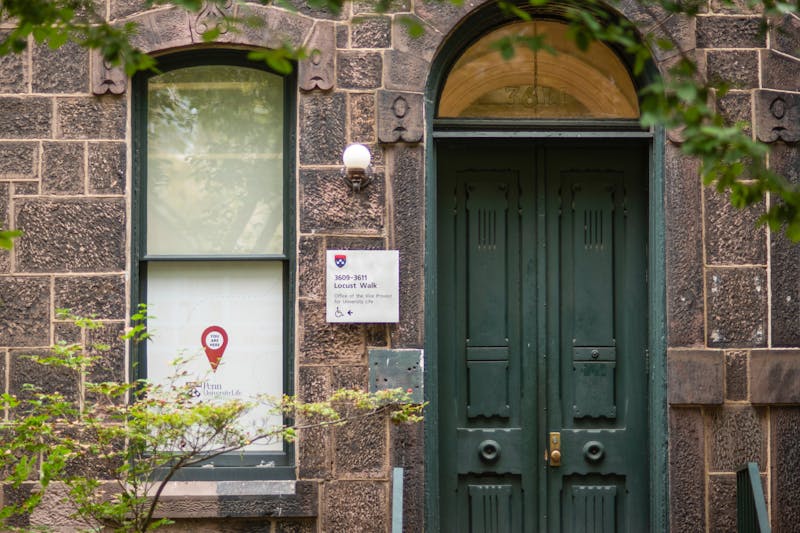
It's been 125 years, and there are thousands of women to thank. They have paved the way for the women on campus today -- for their Steve Madden feet, their Diesel-clad legs and their Clinique-powdered faces.
But while there is no denying that many gender signifiers on this campus remain strong, women have come a long way. In the past, they were restricted to fortress-like Hill House -- now many dorms feature coed-optional bathrooms. Before, they took classes only in Bennett Hall, but now they study even male-dominated fields such as engineering and business.
From the campus social scene to the University's top administrative positions, women are constantly reforming their roles at Penn and straining against what once seemed like an impenetrable glass ceiling.
Some say that no matter what progress women make, campus hotspots like Smokey Joe's, Billybob and the Saturday night fraternity party are still nothing more than social meat markets.
Part of the problem, some say, is a dichotomy between the intentions of men and women in the campus night life.
"Guys and girls have different motives for going out," College sophomore Kristy Green said. "Girls go out to have fun and get dressed up, and guys go out to meet girls and get drunk."
But many students said these stereotypes are not representative, that most college students have the same basic motivations for going out, regardless of gender.
"Men and women are looking for the same things when they go out -- they want to have a good time, to meet someone," Engineering senior Cassy Celler said.
But it seems like throughout much of campus, gendered norms are still a social reality. The rituals of dating, for example, seem unshakable.
While it may be increasingly acceptable for women to invite men out, the idiosyncrasies of the dating scene are by no means obsolete. For instance, coyness is still a feminine virtue, so sororities continue to use "crush parties" as a way of circumventing direct propositions. Yet this type of event is unheard of for fraternities.
"It's just girly human nature," Panhellenic Council President Kristen Buppert says. "Stereotypically, girls don't ask guys out."
And the disparities between fraternity and sorority life go deeper than that, some Greeks say.
Sororities and fraternities have virtually identical mission statements and goals -- both are expected to be charitable institutions as well as to serve as social and academic support systems for their members. But several sisters say that while sororities are understood as philanthropic organizations, frats often fell short in promoting this model.
"I think that sororities have a good reputation, they do a lot of good things," says Celler, a member of Alpha Chi Omega. "During rush time, there may be a perception of pettiness, but during the year we do lots of philanthropy and charity events."
"Frats are not really seen as charitable organizations, as much as they are social or places to go and drink," she adds. "Maybe that's just a stereotype of women versus men."
Buppert also says that the disparities between the two sides of the Greek system are a result of traditional gender roles.
"The differences between sororities and fraternities are basically the differences between women and men," Buppert said.
Nevertheless, fraternities sustain the majority of the Greek population on campus. With 38 recognized fraternities on campus and only seven Panhellenic sororities, the Greek system draws 30 percent of male undergraduates and only about 11 percent of women, according to the Office of Fraternity and Sorority Affairs.
"Our recruitment system may be intimidating for freshmen women," Buppert says. "Boys will be boys -- the fraternity recruitment system is much more lax. But we want to make sure ours is as fair as possible."
One issue that may drive women away from the Greek system is the sorority girl stereotype prevalent on campus.
"It's really frustrating," Buppert said. "People come up to you and say, 'All you do is drink, all you do is party, all you do is get bad grades.' But we know that's not the case. How can you possibly stereotype that many girls into one mold?"
Over the past year, women on campus have worked to shatter even more stereotypes by earning some of the top positions in the traditionally male-dominated student government organizations.
Women leaders have taken charge in the Student Committee on Undergraduate Education, the Undergradate Assembly and the Nominations and Elections Committee. And last week newly elected Student Activities Council Chairwoman Latoya Brown broke a Penn record by becoming the fourth woman elected to a student government leadership position in a single year.
"I think it's a tribute to all of the women who came before us that I can feel empowered and I don't notice that I'm a woman in a male-dominated society," says SCUE Chairwoman Lindsey Mathews, a College senior. "Gender wasn't something that I thought about at all."
The increase of women in leadership positions across campus may be partly due to the greater number of female role models, inspiring more and more women to follow in their footsteps.
"There are a lot of women leaders in pretty much every organization on campus," says NEC Chairwoman Anne Hankey, also a College senior. "Once you have a women in a leadership role, it serves as a role model for other women.... It shows you that you don't have to be the stereotype of leadership to be a leader."
Several students in top positions note that their rise to power may have actually been due to, rather than in spite of, the fact that they are women.
"Just as easily as it could be a coincidence, it could be that the female style of leadership may be the more intuitive, softer style of leadership, associated with women is something that people look to," Mathews said.
UA Chairwoman Dana Hork, a College senior, adds that she, too, often looks to less confrontational techniques.
"I'm not sure if it's because I'm female, but my own personal style is much more about relationship-building than about the UA being a combative force," Hork said.
Most of these leaders said that, because they took a more saccharine approach to leadership, they avoided some stereotypes that have often been associated with females in powerful positions. But some epithets linked to female authority figures may be hard to shake.
"I think that's something that unfortunately is always going to be an undercurrent," Hankey said. But "as there are more women leaders, people become used to having women in leadership roles. And then it doesn't become that she's power hungry and a bitch. It becomes that she is someone there who is equal to having a male there."
But on the other hand, a gentler leadership style can sometimes be perceived as a weakness in female leaders.
"I sometimes get called a wuss or a cheesy girl," Hankey said. "There are positive and negative sides to any style of leadership and it kind of depends on who's talking about you."
Baldwin also said that being a woman in student government requires a little extra aggressiveness.
"In the past couple years, I've had to assert myself, being one of two women in the group," she said. "Sometimes you have to be especially assertive to be heard over the males."
Women have also found the need to be assertive in hawking tickets to their shows to passersby on Locust Walk. And it seems that while many students have heard of Mask and Wig, Penn's century-old, all-male comedy troupe, fewer may have seen Bloomers, its female counterpart, in action. And the same goes for many of Penn's other all-female groups.
But College freshman Ariel Schneier, a member of Bloomers, says she thinks the gap is due to the tradition of older groups, like Mask and Wig and the all-male Glee Club, both of which benefit from strong alumni support systems.
"People don't know as much about us as our counterpart Mask and Wig, but they're also older, they have a little more money and a little more reputation behind them," Schneier says. "Hopefully that will change."
But there are many opportunities for women to participate in the performing arts, and some say they believe the gap between men's and women's groups will continue to narrow.
"There's all sorts of coed groups out there," Schneier says. "There's almost as many options as there are for guys, but they've been around longer."
But in other parts of the performing arts community, women have come to the forefront of both coed and all-women's organizations.
"I definitely do feel like it's pretty equal in performing arts," says Virginia Graham, Dance Arts Council chairwoman, financial coordinator of the Performing Arts Council and chairwoman of PennDance.
"There are a lot of women involved, and in the dance community there are probably about 10 times as many women as men," she said. "The DAC chairs have been all women for as far back as I can remember. In PAC, there are probably about an equal number of men and women."
With women now comprising virtually half of the student body at Penn, the old image of the classroom as a boys' club seems to have dissipated.
And while the gender distribution across several fields of study remains unbalanced, many female students say they feel that the classroom is a comfortable environment where gender is not relevant.
"I'm in engineering, so my classes are very male-oriented," Celler says. "There are four girls out of 24 in my class of chemical engineering. I think you just get used to it. I don't find myself at a disadvantage at all."
"In the beginning it was [daunting], but I really don't feel like it's an issue at all," she says. "I've seen that it's all what you make of it. If you want to speak up in class, you do."
But while female students repeatedly say that they think gender has not played a role in their educational experience, some female faculty feel differently about their roles in Penn's academic community.
Several professors say that sexism and gender disparities exists in their departments, though it seems to vary among departments. Some of the issues addressed by female professors included a wage gap between men and women. One also mentioned that as the number of women in a department increases, the wages in that department tend to fall.
"Women still work harder and make less money than men with the same level of accomplishment," English Professor Vicki Mahaffey says.
Mahaffey blames much of the incongruity on the lower numbers of female professors -- only about 24 percent of College faculty is comprised of women, which leads to problems in dedicating time to committee work.
"If you believe that women should be represented on important committees -- given that there's a smaller pool of women -- individual women end up doing more committee work," she says.
And, Mahaffey acknowledges, the English Department is nearer to gender equity than many other areas of the University. While the faculty of the Nursing School is 98 percent female, in Penn's other schools the prevalence of male professors is overwhelming. Women make up only 13 percent of the Wharton faculty and a mere 6 percent of all Engineering faculty.
But even so, faculty members are quick to point out that the University has made progress.
"Penn is better than many universities, but it still has a way to go," says Mahaffey, who has worked in Penn's English Department for 22 years. It's certainly better than it was when I got here."
And this imbalance may effect not only professors, but also students who seek out female role models in academia. But some faculty have hope that the growing, though still relatively small number of female academics will encourage still more to enter the field.
"It's gotten a lot better," Mahaffey says. "When I was a student in college, I had one female professor."
With a woman as University president, it is easy to assume that administration at Penn is a virtually genderless environment.
But Judith Rodin says she knew that her gender was significant when she became the first female president both at Penn and in the Ivy League.
"It was the first time in a long time in my career where gender felt like an issue again," Rodin says. "And then when suddenly it was made such a big deal of -- and I had to remember that what I did mattered because of the way that it impacted how people viewed women, as well as the Penn president -- it was both exciting, but I think it added an additional burden."
And she was faced with challenge of breaking into what had been a male-oriented business environment, filled with gendered stereotypes.
"I know that there was some concern initially among some of the trustees that a woman president might not be as interested in athletics," she says. "And there was some concern that when so much is done on the golf course, or wherever, that a woman president might not be interested in fundraising."
Rodin says that while being a woman in power has not recently created tension with her male coworkers, it is an issue she had to deal with over the course of her career.
"I was aware of gender-specific expectations," Rodin says. "And when I exceeded these gender-specific expectations I was called aggressive. When men do that, the same set of behaviors, they're called ambitious, and it's positive."
Other female administrators second Rodin's statement that their work environments were not tinged with gender issues.
"It's very comfortable being a woman administrator," Graduate School of Education Dean Susan Fuhrman says. "You don't have any sense that there is any difference between being a woman administrator or a male administrator."
But even so, discrepancies are apparent -- and female deans regularly come from traditionally feminized fields such as nursing and education, while top posts in other schools are held by men.
"There are fewer women full professors across the University and fewer female administrators, so there's kind of a pipeline issue of fewer women being prepared for this sort of position, fewer women having the experience of running major research centers," Fuhrman says. "It's a pool issue -- in education and in nursing, there are more available applicants" for top positions.
But despite "pipeline" issues, the increase of women administrators across Penn and its peer institutions does offer hope.
"Look at Ivy League colleges," Fuhrman says. "There are three women presidents, all from non-traditional female fields."
Women at Penn have made progress and gained prestige in areas that might have seemed impossible to their first predecessors more than a century ago -- when even gaining access to the classroom was a difficult feat.
Now under the guidance of a female president and many women leaders, Penn seems to hover along a rare balance between female empowerment and adherence to traditional gender norms. Despite the inequalities of this relationship, many women said they accept it as an adequate compromise.
The Daily Pennsylvanian is an independent, student-run newspaper. Please consider making a donation to support the coverage that shapes the University. Your generosity ensures a future of strong journalism at Penn.
DonatePlease note All comments are eligible for publication in The Daily Pennsylvanian.







